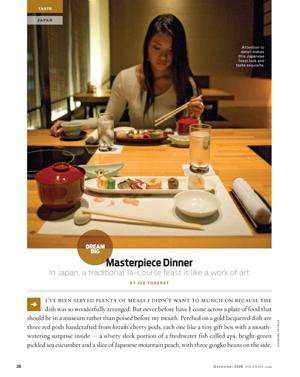Taste: Japan's Kaiseki
I've been served plenty of meals I didn't want to munch on because the dish was so wonderfully arranged. But never before have I come across a plate of food that should be in a museum rather than poised before my mouth. Perched on a gold lacquered dish are three red pods handcrafted from hozuki cherry pods, each one like a tiny gift box with a mouthwatering surprise inside — a silvery sleek portion of a freshwater fish called ayu, bright-green pickled sea cucumber and a slice of Japanese mountain peach, with three gingko beans on the side.
My appetizer is one of thousands of unique and often rare dishes that comprise kaiseki, little known outside Japan but undoubtedly the island nation's most sumptuous feast. With 14 dishes interspersed with small talk and sips of premium sake, a typical kaiseki dinner takes two or three hours to complete — assuming that you can actually get yourself to consume the edible artwork. The artist in my case is Yoshihiro Murata, one of Japan's most renowned kaiseki chefs and the creator of a magical eatery called Kyoto Kikunoi hidden in the hills above Kyoto's historic Gion District. Very hidden. Several times I have to flag down bystanders
to find it (there is no English sign). And when I finally arrive, the ancient building reminds me of a traditional Japanese home rather than a posh eatery.
My second challenge is overcoming the sticker shock: A 14-course dinner at Kikunoi runs about $250 per person; my eight-course lunch will cost around half that. Is there a meal worth that much? I'm about to find out.
Stepping out of my shoes at the front door, I am handed a pair of slippers by a hostess clad in a pea-green silk kimono. She leads the way up a flight of narrow wooden stairs to the second floor and leaves me in a private tatami suite in which there is not a single piece of furniture. I'm taking this meal on the floor. The silence is broken by the appearance of a geisha-like waitress with green tea, a chilled towel and an exquisite teaser: mint jelly with a garnish of tiny Japanese maple leaves on a gold plate decorated with a bamboo motif.
Despite its popularity in Japan, kaiseki is rarely found elsewhere because of a painstaking reliance on fresh ingredients, many of which I came across during a stroll through the sprawling Nishiki Ichiba food market in central Kyoto on my way to lunch at Kikunoi.
Ingredients change according to the seasons, and many of them come straight from Japanese farms, forests and coves. Most of the courses are either vegetable- or seafood-based, although in modern times some of the more cuttingedge chefs (like Murata) venture into carnivorous territory. Like browsing a museum or gallery that rotates its masterpieces, one of the marvelous things about kaiseki is that you can come back tomorrow for something completely different. Not a single course is repeated. My waitress sinks to her knees, bows low and announces the formal start of the meal. After pouring a cup of sake, she removes the cover on my first course — the cleverly crafted tomatoes — which set the summer-hued theme for the feast. And so it flows from there through seven more courses, all of them different in flavor and appearance, with names I can barely pronounce and like nothing I have ever before tasted. As I tenderly devour my shiizakana hotpot — boiled eggs, roasted eggplant and fish seasoned with mitsuba (Japanese wild parsley) and sansho (pepper powder) — I wonder about the ancient monks who supposedly created this feast.
Kaiseki originated during medieval times as a humble repast to accompany the Japanese tea ceremony. The name means "stone in the bosom" and derives
from the tradition of Zen monks placing hot stones in their robes to ward off hunger. No irony is lost in the fact that kaiseki slowly but surely evolved from nassuming alms food into a lavish spread enjoyed by shoguns, samurai and the wealthiest merchants.
What would those monks say about kaiseki's transformation into such a flamboyant meal? Would they, like I'm doing, simply lose themselves in this amazing world of flavors?
Not only are there a set number of courses, but they must be served in a certain order to achieve the desired effect — something approaching rapture in the awestruck eater — an elegantly choreographed dance through dishes that are alternatively hot and cold, sweet and sour, vaguely familiar and incredibly exotic. Yet within these long-established courses, chefs experiment with flavors, colors, textures and arrangements. Murata's forte is creating never-before-seen dishes within the framework of tradition.
Each dish moves me in a slightly different way. A chilled ichijiku (boiled fig) in white miso really is something to savor on a hot summer day, while the sumptuous mukozuke seafood course — thinly sliced onaga (red snapper) and hamo (conger eel) sashimi served on a lotus leaf with sour ume (plum) sauce and wasabi mustard — makes me long for the sea. Not the Japanese coastline of today, but the idealized shore of old woodblock prints, whitecaps breaking on a beach beneath Mount Fuji.
That's the beauty of kaiseki, the reason for all the fuss. It's a journey through space and time rather than some ordinary meal. The dishes beg my contemplation in the same way that I might ponder a Zen garden.
